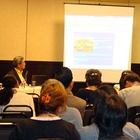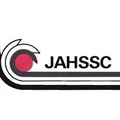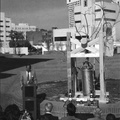SÃO PAULO, Brazil — Overall over 500 participated in the joint convention of the Association of Nikkei and Japanese Abroad (48th annual Kaigai Nikkeijin Taikai-KNT) and Asociación Panamericana Nikkei (14th Convention of Panamerican Nikkei-COPANI) from July 18-21, 2007. There were 245 Brazilians, 156 from the Spanish-speaking countries such as Peru, Paraguay, Mexico, Argentina, Chile, Bolivia, etc., and 66 from English speaking countries, the United States, Canada and Australia.
For the first time, delegates from Indonesia, Venezuela and New Caledonia participated. Uruguay will host COPANI in 2009 with Argentina and Paraguay Nikkei assisting the Japanese colony there comprised of around 100 families.
São Paulo is a metropolis of around 19 million. Some have estimated there are 1.5 million* Nikkei in Brazil, with a large number within the state of São Paulo. It is estimated 310,000 more Brazilian Nikkei live in Japan as dekasegi immigrant workers.
The convention site, Hotel Blue Tree Ibirapuera, happens to be owned by a Brazilian Nikkei, Mrs. Aoki (which translates as Blue Tree).
Weather in July (midwinter in South America) was a bit rainy (misty in Lima), streets wet in São Paulo, Rio de Janeiro and at Iguazú Falls over my 14 days away from Los Angeles. But we noted the temperatures rose to 36°C (93°F) in Rio and we were on a city tour bus driving by Copacabana beach too fast to see any girls in strings.
-
*Note: The 2007 World Almanac lists Brazil’s population at 186,078,227. Wikipedia, the free encyclopedia, shows 0.8% of Brazil’s population is Japanese (nipo-brasileiro in Portuguese), according to its resource team comprised of Juliana Imai, Dan Nakagawa, Fernando Takai and Luiz Gushiken.
Simultaneous translation featured
The plenary joint APN-KNK session (which I attended and enjoyed, thanks to simultaneous translation ) dealt with Nikkei societies and issues within their respective countries. Nikkei identity, indeed, varies from country to country.
On the other hand, the APN Delegates' session (without instant translation ) saw two members from Chile (Roberto Hirose) and Colombia (Carlos Nishi), sitting next to Peruvian-born PANA-USA president Arturo Yoshimoto, exchange seats with Art and Keiko Miki from Canada who were across the square spread of 50 seats, when much of the pros and cons of where to hold the next convention and an establishment of a $1 million endowment fund became heated questions.
Thus with the pair from Winnipeg, Canada, joining Lillian Kimura, PNA East, and Lea Hayashi, PANA-USA, Yoshimoto served as an anchorman to the English-speaking sector.
APN president Felix Kasamatsu has revealed that the lawyers’ group and subcommittee will research the institutional structure to establish an international non-profit organization fund.
Challenge and Hope of Keynoter
The convention theme, The Nikkei Contribution in the Progress of Society, called for “going back to the basics of the Nikkei world abroad and promoting the development and role of the community” in dialogue between seniors and the younger generations as keynote speaker from Japan Prof. Kotaro Horisaka of Sophia University , began his address.
He reviewed the history of Kaigai Nikkeijin Kyokai (KNK), which was formed in May, 1957. Its annual conventions appealed to overseas Nikkei in business and students studying in Japan. Since 1990, Brazilian dekaseg i began to participate. The number of countries represented at KNK conventions has ranged from five to its largest number, twenty-one, in 2001.
The Emperor and Empress attended the 40th KNK convention in Tokyo in 1999. An Imperial Family member customarily appears at these conventions.
KNK has also assisted in various projects of JICA (Japan International Cooperation Agency), which appears similar to America’s Peace Corps. Its conventions have served as a forum for social interaction among Nikkei. Recent resolutions called for adaptation of lessons from overseas Nikkei for new development of prosperity in the other Nikkei communities, on energizing the Japanese language program for Nikkei and restoring the former Kobe Emigration Center that withstood the great 1995 Hanshin earthquake. Part of the center houses a school for Portuguese and Japanese lessons.
Meaning of ‘Nikkei’ changing
The semantics over “Nikkei” in homogeneous Japan, once reserved to mean an “emigrant,” has acquired a new image, Horisaka stated. Around 1990, the word began to mean the foreign-born Nikkei who came to live and work in Japan. In America, the term has been inclusive of all persons of Japanese ancestry, even “children of international marriages [and] of corporate Japanese employees who have gone abroad and decided to stay,” Horisaka found.
Reflective of Japan’s “Innovation 25 Strategy” launched by Prime Minister Shinzo Abe’s administration for new systems and structures by the year 2025, the Sophia scholar on Latin American economy (especially Brazil) referred to Harvard economist Joseph Schumpeter’s sense of the term: “innovation—the style of activities engaged in by entrepreneurs creating totally new economic aspects.”
Policy makers in Japan have begun discussions on “innovation,” Horisaka said and hoped the Nikkei, “as a self-reliant people” in convention, can contribute the knowledge they have learned in their countries to stimulate Japan. He felt this convention, being convened in São Paulo almost exactly on the opposite side of the world to Japan, will conclude by demonstrating the potential to create a “knowledge” pipeline—a two-way interaction path between Japan and Nikkei communities around the world.
Kasamatsu re-elected APN president
Felix S. Kasamatsu, who was re-elected president of APN (Asociación Panamericana Nikkei), said he was greatly satisfied that APN helped to improve the relationship among the Nikkei leaders in Brazil to participate equally with KNK from Japan and positive understanding among APN worldwide and notably within Brazil, where there are hundreds of Nikkei associations. Venezuela and regional Hawaii have been invited as new members.
Tsukada heads KNK
KNK President Chihiro Tsukada, former Japanese Ambassador to Brazil, noted the current situation in Japan relating to the environment of Nikkei in Japan and abroad is changing, that “emigration” has become a thing of the past, moving from an era defined by “assistance to emigrants” to a new era defined as “cooperation with Nikkei and viewed the maturing of Nikkei communities in many ways to be welcomed.”
Ambassador Ken Shimanouchi
Japanese Ambassador to Brazil Ken Shimanouchi appreciated the participation of American Nikkei in Japan in bringing Japan into the modern age. He explained Nikkei conventions “with the advance of globalization” continue to have an important role linking Nikkei between themselves and with Japan.
The Japanese government, he added, intends to support the activities of Japanese communities through opportunities such as this joint convention. Incidentally, he is the eldest son of Toshiro “Hank” Shimanouchi, a pre-WWII Occidental College graduate who served as Japanese consul general in Los Angeles during the 1960s.
Mesangens / Greetings from Brazilians
In his welcome message, Brazil’s Secretary of Foreign Affairs Celso Luiz Nunes Amorin expressed that he looked forward to the 100th anniversary of Japanese immigration to Brazil in 2008 and hoped the “symbolism of the centenary can inspire us to sustainable development and cooperation in the area of energy, biotechnology, information technology, nanotechnology and spatial technology.” He also cited the Brazilian community in Japan has reached 313,000, “our third biggest community abroad.”
Noritaka Yano, Brazil’s APN and convention board president, thanked the presence of delegates who came from Japan, Asia (Indonesia), Oceania (New Caledonia), Venezuela and Hawaii for the first time to a PANA convention. The opportunity for Nikkei to interchange, inform and debate between nations will be valuable and strengthen friendly relationships, he said, as well as “getting acquainted with part of our Brazilian culture.”
Reviews from Nikkei communities
Mari Hayman, a Seattle Yonsei and granddaughter of Homer and Miki Yasui of Portland, the lone USA speaker at the KNK plenary session, challenged Nikkei in the U.S. to overcome the communication gap that exists between themselves and those from Japan. “We are Nikkei. We need to know each other.”
In Brazil, the Nikkei population today shows six generations concerned with problems with aging, generation gap, youth failing to meet their parent’s expectations, health issues and financial matters, as a senior delegate cited. The youth added, “We listen to our elders as they are our role models on international projects with Japan,” especially in the area of teaching Japanese in Brazil.
As Brazilian Japanese prepare for their immigration centennial next year, scholarships and home stay programs for youth in Japan from the Japan Foundation and prefectural societies in Brazil are anticipated. Baseball, sumo, soccer tournaments, queen contests and taiko championships are on the 2008 agenda.
Venezuela: ‘But we are not united’
In Venezuela, its delegate was looking forward to their 80th anniversary of Japanese immigration next year, “but we are not united,” citing most Nisei do not speak Nihongo. Yet, the Venezuelan youth declared, “The Nisei-Sansei are pillars in our community.”
In Peru, problems exist in Nikkei communities with respect to Japanese language, and that many young Nikkei do not join existing Nikkei organizations except for sports and theater. A strong case was made for a junior chamber of commerce to promote networking and support by Sansei to take action.
In Mexico, the question was “how can Nisei transfer their heritage to the younger generation.” There are 25,000 Nikkei in Mexico, as publicized during the 2006 celebration of their 110th anniversary of Japanese immigration. When considering Nikkei of mixed marriage where the first language is Spanish, their population mounts to 70,000; many are in the state of Chiapas where the first Japanese landed in 1896.
Rather than concentrating on a negative problem, the youth from Mexico said, “We shall concentrate and embrace this dream (of a great Nikkei society) to ensure the future of our society.”
Chile: Seeks business aid
In Chile, while many Nikkei are well educated and in professions with little time to promote Japanese heritage, it was hoped that Japanese companies in the country can help in this endeavor.
In Argentina, where the first Japanese came in 1908 through Brazil, Nikkei dekasegi are returning now from Japan, thus able to contribute to schools, promote cultural connections in government and also care of the elders.
In Paraguay, the population of Nikkei in five Japanese farming colonies and four cities stands at 70,000. Many young people are eager to meet other Sansei. While some hesitate to pursue education at the college-university level, many realize the value and importance of Japanese heritage. Paraguayan dekasegi are also returning from Japan, the expectation being they can teach Japanese to the younger generation.
In Bolivia, Nikkei identity has been maintained through language schools and the promotion of cultural heritage continues. Nikkei are also “well-regarded” as a class in the country, its delegate added, and addressing their own community problems in health and education.
Japanese Picture in Indonesia
The lone delegate from Indonesia, Heru S. Eto of Jakarta noted there are some 300 different ethnic communities in his nation and that promoting educational awareness of Japanese language is “a real problem,” but working with a college in Tokushima for assistance has been worthwhile. The Japanese colony of 3,000 in Bali is very interactive in the community, Eto indicated.
One source reminded the convention attendees that 1,200 Japanese orphans were abandoned in the Netherlands East Indies during World War II; another 120 Japanese war veterans are buried in Indonesia; and over 1,900 Japanese aliens were interned during WWII in Australia.
Other Nisei in this camp were stunned to see the Indonesian group when they arrived in February 1943, grabbing leftover food, bread, butter, etc., into their clothing. “It took a while to convince them there was no need for such behavior,” Evelyn Suzuki of Sydney recalled at the Topaz Camp reunion in San Jose, California, in 1998.
Workshops for Various Topics
The plenary session lasted six hours. At other workshops, Dr. Akemi Kikumura-Yano and Yoko Nishimura from the USA at the “History of Japanese Immigration,” and Lillian Kimura at the “Women in Society” addressed their respective sessions. On the women’s panel were a choral director from Peru, the wife of a former Paraguayan ambassador to Japan (Emi Kasamatsu), a Brazilian filmmaker (Tizuka Yamasaki), a federal court of appeals judge (Consuelo Moromizato Yoshida), a conductor of the São Paulo Symphony Orchestra, and a lieutenant from the Brazilian Navy. “These women with impressive credentials had interesting stories to tell,” Kimura added.
One point at the workshop on “Dual Nationality” focused on Japanese nationality law as it affects the dekasegi from Brazil, who have their children born in Japan and who are stateless, i.e., not recognized by either Japan nor Brazil, and procedures to be taken in the future.
A special program on Nikkei in the Military, coordinated by Army General Akira Obara, included a visit to Brazil’s aeronautical center and to Embraer.
The workshops for Nikkei doctors, chaired by Dr. Renato Yamada, visited two hospitals where Nikkei are hospitalized and met at Hospital Brasil; and for Nikkei dentists at Hotel Blue Tree, chaired by orthodontist Dr. Ziro Yanagimori, where a Pan American Nikkei Dentists Association was proposed.
Meetings for attorneys, youth, “Japanese Language and Culture,” “Employment in Japan,” and “Influence of Japanese Music Songs” were held at the Bunkyo Japanese cultural center in Liberdade.
A summary of the ten workshops was delivered at the closing ceremony dinner Saturday during a two-hour speech fest, followed by a buffet dinner of typical Brazilian fare. Those nodding during the speeches were certainly wide-eyed when skimpily dressed dancing girls and samba band appeared unannounced in the banquet room. Instead of a conga line, it immediately became a photo-op session.
July 20, 2007: Visit to the historic city of Registro
A highlight of the four-day convention, among the many, was this memorable one-day trip to Registro, 117 miles southeast from São Paulo, and titled “Japanese Settlement Landmark” by the State of São Paulo. The city of Registro has a population over 60,000 of which 10% are Nikkei.
“We took a three-hour trip to Registro, the first Japanese tea colony in Brazil,” PNA-East president Lillian Kimura of New York, reports. “We were told that tea from Sri Lanka was smuggled in loaves of bread.” The tea farm began in 1935.
Tea from the original planting continues to be carefully nurtured and picked by hand, whereas other bushes come under machines. Original bushes thrive on a slope visited by delegates. Cultivation of palm hearts, bananas, lettuce and white rice—national staple for Brazilians, rich and poor, are major crops in the valley.
At the annual memorial service for Issei pioneers, Tôro Nagashi —lantern offering in the river—is an important date on the city hall calendar. It is led by a priest from Registro Buddhist Temple, with prayers from a Japanese Catholic priest from St. Francis Xavier Church, an old Japantown edifice, and from several Protestant ministers.
During the colonial era when gold was discovered in the 1500s in the Ribiera Valley, prospectors registered their findings at a village port by the river, hence the municipality’s name, Registro.
After the gold period passed, the small community was renewed by the Japanese in the 1900s through agriculture and commerce. The Japanese Overseas Company for Development, Kaigai Kogyo Kabushiki Kaisha, introduced a rice processing machine for Registro, the first in Brazil, building warehouses and the mill (except during WWII) until the 1980s.
Known as the Japanese Immigrant’s House in Registro, the two-story building has been rebuilt in Meiji-Mura, a museum and theme park in Inuyama near Nagoya, Japan. The park opened in 1965, its main entrance being the Frank Lloyd Wright’s Imperial Hotel and lobby in Tokyo that withstood the 1923 earthquake.
On our last day in South America, a visit with an Argentine Nisei (Alfredo Tamagusuku) in Buenos Aires was a welcome occasion away from big boulevards of the capital. Stranded as a youth in Okinawa during WWII, he returned in the 1950s to become a successful horticulturist in the community of Moreno (about 25 miles west of Buenos Aires), where about 100 Japanese live, also engaged in growing flowers wholesale-retail.
‘Viva - Banzai - Thank You’
Back home in Maryland after the APN / KNK joint convention in São Paulo, PANA international president Felix Kasamatsu expressed his appreciation to delegates, observers, special guests and to Noritaka Yano, APN Brazil president who organized the convention committee. “We all know in a country like Brazil with large Nikkei communities and many organizations, it is not easy to coordinate this kind of an event.”
APN took the initiative to jointly hold the convention and Kasamatsu said, “We will continue to do so in the future.” And for the first time, 18 young leaders from nine countries of the Americas participated with Nikkei seniors on current issues and the future of Nikkei society.
Of all the good news and congratulations received from participants, TV and press, Kasamatsu added: “We have all gained. It was a great success because of the participation of numerous people from different countries. We have strengthened our relations and as a result the prestige of Nikkei society (Nikkei shakai ).”
APN also announced new members: Venezuela (the 14th country) and U.S. Regional Hawaii. Uruguay will host COPANI XV in 2009 and next in line will be Los Angeles or Hawaii in 2011.
© 2007 Harry K.Honda






